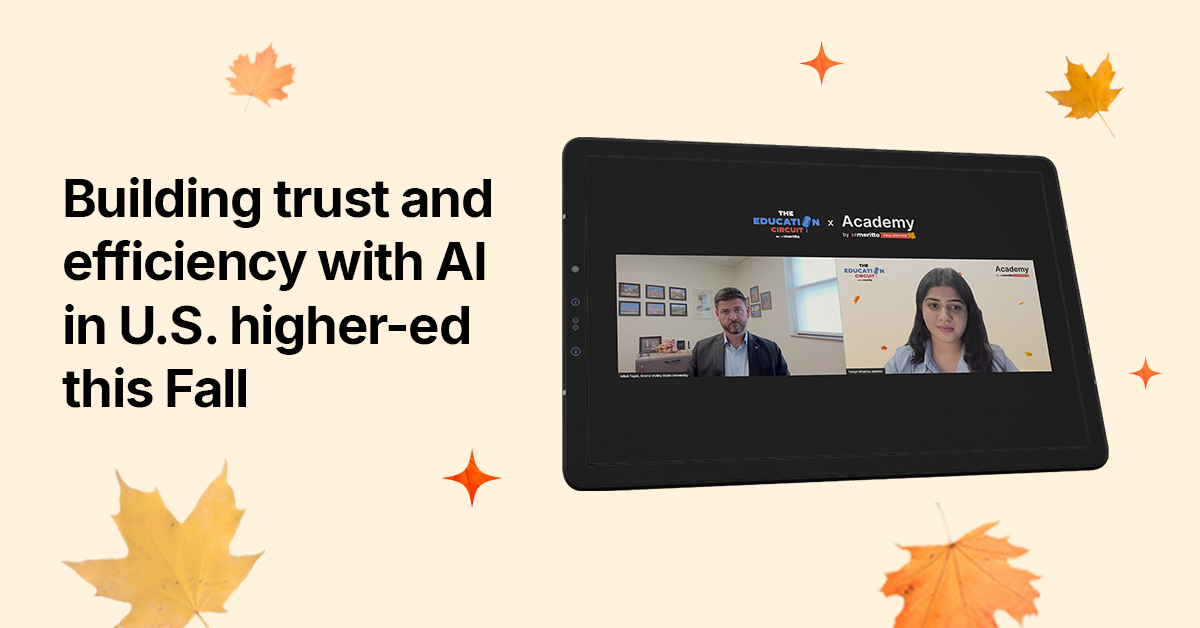Fall has always been a defining season for U.S. higher-ed, but 2025 brings new urgency. With recruitment, and student engagement all converging, institutions are under pressure to deliver outcomes faster, with fewer resources, and with greater transparency. To stay competitive, many are turning to AI and digital platforms that scale operations and create more personalized student experiences.
To better understand this pivotal moment, we hosted a landmark edition of #EducationCircuitByMeritto featuring Miloš Topić, VP & Chief Digital Officer at Grand Valley State University, who brings over 25 years of experience at the intersection of education and technology. The discussion centered on how AI is reshaping enrollment processes, building trust with students and families, and preparing institutions for long-term growth.
Here are the key insights and takeaways from this episode:
Why Fall 2025 is a defining moment for the U.S. higher-ed
Fall is traditionally the busiest season for higher education, but this year stands out as institutions balance tighter budgets, evolving student expectations, and increasing competition. According to Miloš, with the rapid rise of AI tools like ChatGPT, the task now is to ensure these technologies truly serve students, faculty, and staff, aligning innovation with long-term goals to build trust, boost efficiency, and strengthen digital infrastructure.
How AI builds trust in admissions
In Fall 2025, trust is becoming the foundation of how higher-ed institutions embrace AI. As universities explore new tools for enrollment and engagement, the challenge is to move beyond the “black box” perception and create transparency for students, parents, and faculty. The way forward, Miloš explained, is to involve stakeholders, share openly, and demonstrate real results.
“Trust is critical. It comes from being honest, showing what you’re doing and why, and solving problems in ways people can see and believe in,” shared Miloš Topić, VP & Chief Digital Officer at Grand Valley State University, in our latest episode of #EducationCircuitByMeritto.
Where AI delivers the quickest efficiency gains
Operational efficiency with AI starts with strong data. When applied to admissions, AI models can process thousands of applications, compare transcripts, and accelerate decision-making with growing accuracy. While the first and last mile of enrollment will always benefit from human relationships, much of the middle can be automated, reducing manual workloads and freeing staff to focus on high-value interactions. By starting small, testing internally, and then scaling, institutions can redeploy time, cut inefficiencies, and see measurable impact across enrollment and operations.
Challenges in integrating AI into admissions
Adopting AI in higher education requires more than just technology, it depends on leadership, culture, and data readiness. Institutions need the courage to experiment, a culture open to change, and unified, reliable data to build effective AI models.
“It starts with leadership, the courage to try something new. Then comes culture, because if an organization resists change, progress is slow. And finally, you need the right technical investments: clean, unified data on which AI models can truly work,” shared Miloš Topić, VP & Chief Digital Officer at Grand Valley State University, in our latest episode of #EducationCircuitByMeritto.
Digital infrastructure as the foundation
For AI to succeed in higher education, institutions must begin with clear objectives and shared definitions of what they want to achieve. Miloš emphasized that technology only adds value when it aligns with institutional strategy, values, and student needs. That means defining what personalized learning truly means, incorporating student voice in the process, and making proactive investments in technology as a strategic differentiator. Strong governance, the right infrastructure, and empowered teams then ensure AI becomes a catalyst for efficiency, innovation, and student-first outcomes.
KPIs for data-driven decision making
Fall 2025 also brings focus on the right enrollment metrics. “We track things like commitments, orientation sign-ups, housing deposits, CRM responses, and social engagement to see where students are in the funnel,” said Miloš. “But the key measure is retention after the first year, because once students move into their second year, they are much more likely to finish their degree.”
How can institutions begin their AI journey
Not every institution is at the same stage of digital readiness. “It starts with leadership, having the right people to guide the journey and an honest assessment of where your technology and data stand,” Miloš noted. “AI is here to stay, but without clean, unified data and strong infrastructure, it can do more harm than good. The goal is to treat technology as a strategic enabler, not an afterthought.”
Leadership for an AI-driven era
“Leadership in the age of AI starts with self-awareness, knowing your strengths and where to lean on others,” Miloš emphasized. “It also takes courage to call out problems when you see them, and the humility to focus not on being right, but on doing what’s right for students and the institution. That’s how technology becomes a true enabler of progress.”
Final thoughts & next steps
This conversation with Miloš Topić reinforced that Fall 2025 is more than just another recruitment season, it’s a defining moment for U.S. higher education. With AI now firmly part of the landscape, the challenge is to move past experimentation and align technology with institutional values, strategies, and student needs. By building trust through transparency, using data to drive efficiency, and investing in strong digital infrastructure, institutions can reduce friction, guide students more effectively, and lay the groundwork for future growth.
Missed the podcast episode? The full recording is now available here and to know more, schedule a personalized demo today.
- What’s new at Meritto: The quarterly roundup
- Scaling Universities & Colleges with a Higher Education CRM
- Here’s How CRM Software for Preschool Scales Admissions
- The Essential Guide to CRM for EdTech in UAE
- Simplify Enrollment with an Admission Management System




